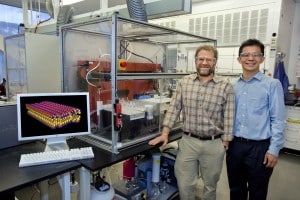Two-dimensional, sheet-like nanostructures are frequently used in biological systems such as cell membranes, and their unique properties have inspired interesting materials such as graphene. Now, scientists from the University of Berkeley have prepared the largest two-dimensional polymer crystal to date that is able to self-assemble in water. This completely innovative material expresses the structural complexity of biological systems containing components that could also be used in functional devices.

"Our findings bridge the gap between natural biopolymers and their synthetic counterparts - a fundamental problem in nanoscience," explains Ronald Zuckermann, director of the Biological Nanostructures Unit. "We are now able to translate a sequence of basic information from proteins into unnatural polymers, giving rise to synthetic nanomaterials with highly defined atomic structures."
The building blocks of the peptoid polymers are cheap, available and responsible for a high utilization of products, which is undoubtedly a huge advantage compared to other synthetic methods. After trying many candidates, the researchers stumbled upon the unique combination of polymeric building blocks that independently form peptoid nanosheets in water.
Using a microscope, the researchers were able to observe the separate polymer chains within the peptoid material, and indeed verify that they are organized in a precise order to form sheets and their unprecedented stability when exposed to electron radiation. "The design of these functional polymers, for which the inspiration came from nature, and which can be incorporated into membranes with large dimensions, express a new chapter for the preparation of original materials," adds the researcher.
"The scientific possibilities associated with this achievement challenge our creativity, and will also help the development of electron microscopy that will allow direct imaging of soft materials."
"This innovative material is an excellent example of molecular biomimicry on so many levels, and will certainly lead to the development of many applications in device manufacturing, nanoscale synthesis and imaging," adds the lead researcher.
The research findings were published in the scientific journal Nature Materials.
